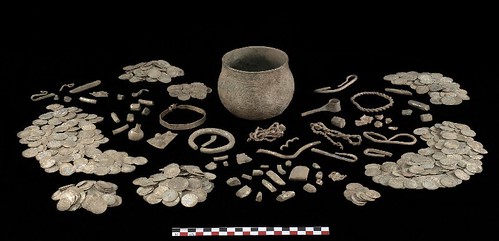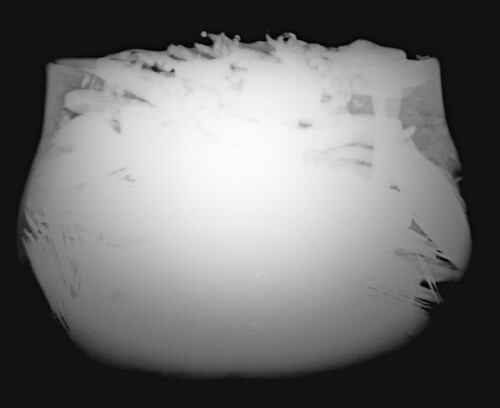 An important Viking hoard of jewels and coins unearthed in England by a father-and-son team of treasure hunters in 2007 has been acquired by the British Museum and the Yorkshire Museum in York. It will go on display next month. The Vale of York hoard – previously known as the Harrogate hoard – is valued at 1.1 million pounds ($1.8 million) and is at least 1,000 years old. It includes objects from Afghanistan, Ireland, Russia and Scandinavia, underlining the global spread of cultural contacts during medieval times.
An important Viking hoard of jewels and coins unearthed in England by a father-and-son team of treasure hunters in 2007 has been acquired by the British Museum and the Yorkshire Museum in York. It will go on display next month. The Vale of York hoard – previously known as the Harrogate hoard – is valued at 1.1 million pounds ($1.8 million) and is at least 1,000 years old. It includes objects from Afghanistan, Ireland, Russia and Scandinavia, underlining the global spread of cultural contacts during medieval times.
The York Museums Trust in York, northern England, and the British Museum in London bought the treasure, which they say is the most important find of its kind in Britain for 160 years, for 1,082,800.
The major Viking hoard was discovered in the Harrogate area in January 2007 by metal-detectorists David and Andrew Whelan. The father and son detecting team promptly reported the hoard to their local Finds Liaison Officer, and displayed exemplary behaviour in not unpacking all the objects from the bowl, but keeping the find intact. Under the Treasure Act 1996 all finders of gold and silver objects, and groups of coins from the same finds, over 300 years old, have a legal obligation to report such items. As a possible Treasure find, it was then transferred to the British Museum where conservators have carefully excavated each find to avoid damaging the individual objects or losing important contextual information.
 It is the largest and most important Viking hoard found in Britain since that discovered at Cuerdale, Lancashire, in 1840 which contained more than 8,000 objects. Mr Fell, Coroner, commented: “Treasure cases are always interesting, but this is one of the most exciting cases that I have ever had to rule on. Im delighted that such an important Viking hoard has been discovered in North Yorkshire. We are extremely proud of our Viking heritage in this area.”
It is the largest and most important Viking hoard found in Britain since that discovered at Cuerdale, Lancashire, in 1840 which contained more than 8,000 objects. Mr Fell, Coroner, commented: “Treasure cases are always interesting, but this is one of the most exciting cases that I have ever had to rule on. Im delighted that such an important Viking hoard has been discovered in North Yorkshire. We are extremely proud of our Viking heritage in this area.”
For David Whelan and his son Andrew, who made the discovery, it was a treasure hunter’s dream come true. “Being keen metal detectorists, we always dreamt of finding a hoard, but to find one from such a fantastic period of history is just unbelievable,” father and son said in a statement. “The contents of the hoard we found went far beyond our wildest dreams and hopefully people will love seeing the objects on display in York and London for many, many years to come.” They will divide the proceeds from the sale with the owner of the land where it was found.
Like other Viking hoards of the period, the Vale of York hoard contains a mixture of different precious metal objects, including coins, complete ornaments, ingots (bars) and chopped-up fragments known as hack-silver. The hoard also shows the diversity of cultural contacts in the medieval world, with objects coming from as far apart as Afghanistan in the East and Ireland in the West, as well as Russia, Scandinavia and continental Europe.
 The most spectacular single object is a gilt silver vessel, made in what is now France in the first half of the ninth century. It was probably intended for use in church services, and was believed to have been looted by Vikings from a monastery or given to them as a tribute. Most of the smaller objects were hidden inside this vessel, which was itself protected by some form of lead container. As a result, the hoard was extremely well-preserved.
The most spectacular single object is a gilt silver vessel, made in what is now France in the first half of the ninth century. It was probably intended for use in church services, and was believed to have been looted by Vikings from a monastery or given to them as a tribute. Most of the smaller objects were hidden inside this vessel, which was itself protected by some form of lead container. As a result, the hoard was extremely well-preserved.
Other star objects include a rare gold arm-ring, and over 600 coins, including several new or rare types. These provide valuable new information about the history of England in the early tenth century, as well as Yorkshires wider cultural contacts in the period. For instance, one of the hoard’s coins teaches us that worshippers of Thor were being encouraged to Christianise their allegiance by switching the Scandanavian god for Peter, as it features St Peter but also the hammer of Thor. Interestingly, the hoard contains coins relating to Islam and to the pre-Christian religion of the Vikings, as well as to Christianity.
Conservation work has recently started on the hoard to restore it to its former glory. More information on the hoard has come to light through this process. The vessel which contained most of the hoard can now be seen to be decorated with niello (a black metal inlay), as well as extensive gilding. New details are also visible in the decoration of some of the silver jewellery fragments, and in the designs and inscriptions of the coins.
The hoard was probably buried for safety by a wealthy Viking leader during the unrest that followed the conquest of the Viking kingdom of Northumbria in AD 927 by the Anglo-Saxon king Athelstan. The Viking army conquered Northumbria in 869 and it remained under Viking control for nearly 60 years.
This major Viking hoard, an important and exciting find, is joint-owned and will be displayed equally between the two partners. Highlights of the hoard will go on display at the Yorkshire Museum in York from September 17 to November 1 before moving to the British Museum.